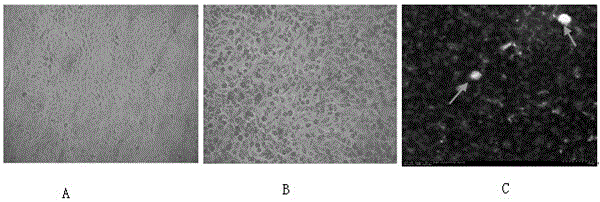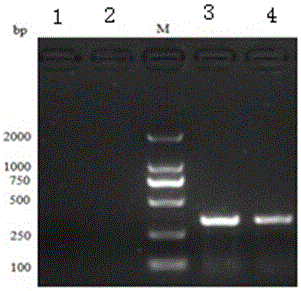Method for cultivating hepatitis e virus
A technology of hepatitis E virus and virus, which is applied in the field of successfully culturing hepatitis E virus strains in vitro and improving the replication efficiency of progeny viruses, and can solve problems such as restricted replication of HEV viruses
- Summary
- Abstract
- Description
- Claims
- Application Information
AI Technical Summary
Problems solved by technology
Method used
Image
Examples
Embodiment 1
[0019] Embodiment 1: A549 cell culture
[0020] A549 cells (purchased from ATCC, USA, number CCL-185) were taken out of liquid nitrogen and quickly placed in warm water at 37°C to rapidly melt the cell suspension; then cultured in DMEM containing 10% newborn bovine serum (purchased from GIBCO Invitrogen Corporation) Adjust the pH to 7.2 and incubate at 37°C for about 4 hours. Discard all the culture medium and add fresh culture medium to continue the culture. After growing into a dense monolayer, wash the cells with PBS (purchased from GIBCO Invitrogen Corporation) and trypsin-EDTA (purchased from GIBCO Invitrogen Corporation) to digest, add the above culture medium, and place at 37°C, 5% CO 2 Continue culturing in the incubator, such as figure 1 A Normal A549 cells are shown.
Embodiment 2
[0021] Embodiment 2: Cultivate HEV with the DMEM medium that adds the pregnant woman's late serum
[0022] 1. Prepare a PBS (pH7.4) feces suspension with a weight-volume ratio of 10% from the collected HEV-positive feces for HEV isolation, shake vigorously to emulsify the feces, centrifuge at 12,000g for 10 minutes at 4°C, and collect the supernatant. 0.22μm filter membrane filter to sterilize, add double antibody solution (400U / mL penicillin and 1000U / mL streptomycin) with 2% volume of virus solution, treat at 4°C for 1h, store at -80°C for later use, and detect the virus by Real-timeqPCR The copy number is 2×10 6 Copy number / mL;
[0023] Isolated from HEVRNA-positive pig feces samples in Kunming, Yunnan, China, the genotype is type 4, and the GenBank database number is No.JF747598;
[0024] 2. Dilute the cells (A549 cells) in Example 1 by 2×10 5 Inoculate each well into a 6-well plate, and use DMEM medium containing 10% fetal bovine serum by mass percentage at 37 °C, 5% C...
Embodiment 3
[0033] Example 3: (1) HEV virus (isolated from HEVRNA-positive pig feces samples in Kunming, Yunnan, China, genotype 4, GenBank database number No. JF747598) solution was sterilized through a 0.22 μm filter membrane, and the virus was added Double antibody solution with 1% solution volume, treated at 4°C for 1 hour, and stored at -80°C for later use, the virus copy number was determined to be 2×10 by Real-timeqPCR 6 Copy number / mL, where the double antibody solution is a solution containing 400U / mL penicillin and 1000U / mL streptomycin;
[0034] (2) Divide A549 cells into 2×10 5 Inoculate each well into a 6-well plate, and use DMEM medium containing 10% fetal bovine serum by mass percentage at 37 °C, 5% CO 2 Culture the cells statically in the incubator until the cells grow into a monolayer;
[0035] (3) Inoculate 100 μL of the HEV virus suspension in step (2) into a single layer of cells, incubate at 37°C for 1 hour, and shake gently every 15 minutes to make the virus fully ...
PUM
 Login to View More
Login to View More Abstract
Description
Claims
Application Information
 Login to View More
Login to View More - R&D
- Intellectual Property
- Life Sciences
- Materials
- Tech Scout
- Unparalleled Data Quality
- Higher Quality Content
- 60% Fewer Hallucinations
Browse by: Latest US Patents, China's latest patents, Technical Efficacy Thesaurus, Application Domain, Technology Topic, Popular Technical Reports.
© 2025 PatSnap. All rights reserved.Legal|Privacy policy|Modern Slavery Act Transparency Statement|Sitemap|About US| Contact US: help@patsnap.com



